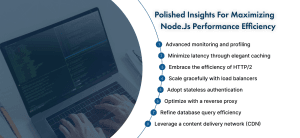 By Jophin September 13, 2024
3 min read
By Jophin September 13, 2024
3 min readKey techniques for enhancing the performance of your Node.js app
Performance in web development isn’t just a technical matter; it’s the bedrock of both user satisfaction and operational achievement. A sluggish application can eventually become a significant hindrance for developers and users alike, while a fast, responsive application will streamline tasks for everyone involved. To boost the application’s speed, developers utilize cutting-edge technologies like Node.js, employing a range of strategies to scale servers effectively and manage high-traffic workloads.
Node.js development services offer a plethora of benefits, including rapid development cycles, efficient data handling, and an MIT license for applications built with it. It’s no surprise that leading industry giants like eBay, PayPal, Uber, and Yahoo have leveraged Node.js in their web development projects, solidifying its reputation as a top-tier technology. However, to ensure your application remains at the forefront, it’s imperative to continuously fine-tune Node.js performance.
This blog delves into tried-and-true Node.js optimization techniques that developers worldwide can use, guaranteeing smoother performance and a superior user experience across the board.
Exploring the frequent performance dilemmas in Node.js performance
Despite the advanced capabilities of Node.js, performance-related challenges are an inevitable aspect of application development. Here’s what your team might encounter:
Sparse documentation: Inadequate documentation can create real-time communication gaps and slow and slow down development, posing challenges for developers. It’s essential to maintain a well-documented project to provide the necessary resources for development teams to effectively study and address these challenges.
Accumulating technical debt: The pressure to deliver rapidly can often lead teams to sacrifice quality for speed, resulting in technical debt that complicates future maintenance and redevelopment. Striking a balance between speed and quality is crucial for ensuring long-term efficiency and optimal outcomes.
Inconsistent process monitoring: Monitoring the application process is a critical responsibility of decision-makers and technical officers. Neglecting this oversight can lead to inflated development costs and prolonged maintenance post-launch. Hire Node.js developers to receive prompt and consistent oversight to manage these challenges effectively.
Polished insights for maximizing Node.js performance efficiency

1. Elevate your application with advanced monitoring and profiling
To truly refine the performance of your Node.js application, a sophisticated approach to monitoring and profiling is essential. Consider these refined strategies to ensure your web applications excel in scalability and efficiency:
- Load Testing: Assess how well your application handles various levels of load by measuring its response times and usage. This practice reveals the system’s resilience and capacity thresholds, ensuring robust performance under stress.
- Scalability Testing: A cornerstone for business growth, scalability testing uncovers and addresses potential bottlenecks and issues that could impede your application’s ability to expand seamlessly.
- Endurance Testing: This rigorous evaluation helps resolve long-term load handling issues and identifies memory leak concerns, ensuring your Node.js application development remains stable and efficient over extended periods.
2. Minimize latency through elegant caching
Caching remains a quintessential method for enhancing Node.js performance. While both client-side and server-side caching are beneficial, server-side caching is particularly effective due to its handling of JavaScript, CSS, HTML pages, and more. The primary advantage of caching is its ability to expedite data retrieval.
3. Embrace the efficiency of HTTP/2
Integrate HTTP/2 into your Node.js application development to unlock unparalleled speed and reduced bandwidth usage. HTTP/2 addresses issues found in HTTP/1, such as multiplexing and header compression, resulting in smoother and faster performance.
4. Scale gracefully with load balancers
Achieve optimal performance by distributing your Node.js application across multiple machines. Use a load balancer to efficiently distribute incoming traffic among servers, ensuring smooth operation across different platforms and operating systems.
5. Adopt stateless authentication
Leverage JSON Web Tokens (JWT) for stateless authentication, which enhances application performance by creating efficient, self-contained tokens upon user login. Hire Node.js developers to streamline API request authentication and speed up user interactions. Additionally, OAuth2 can be used to improve scalability further.
6. Optimize with a reverse proxy
Optimize your Node.js application by using a reverse proxy, which serves as a cache for frequently accessed content. This setup reduces server load and improves response times. Choose a reputable reverse proxy server, such as Nginx, Apache, or HAProxy, and configure it to cache static files and API responses, distribute traffic, and monitor performance.
7. Refine database query efficiency
Boost your Node.js performance through meticulous database query optimization. Employ indexing, minimize query frequency with batching or joins, utilize efficient query patterns, and cache results to reduce server strain and accelerate response times.
8. Leverage a content delivery network (CDN)
Transform your Node.js application’s performance by incorporating a Content Delivery Network (CDN). A global network of servers will cache and deliver static content swiftly, ensuring faster load times and an elevated user experience.
Best-in-class Node.js performance tracking tools
The market is brimming with diverse tools designed to meet various testing needs, including performance monitoring for Node.js development services. Here’s a curated selection of notable tools for effective performance oversight:
1. New Relic: The zenith of real-time analytics
New Relic provides an intuitive Node.js quickstart with elegantly pre-configured observability solutions. It provides a panoramic view of key metrics such as Apdex scores and CPU utilization. Its comprehensive dashboards highlight slow transactions and throughput, while features like Service Maps, Error Analytics, and real-time insights deliver in-depth visibility and actionable intelligence.
2. PM2: The height of technological brilliance
Renowned as a top-tier daemon process manager, PM2 excels in both maintaining and monitoring applications. Deployed via npm, PM2 offers robust CLI-based monitoring for Node.js applications. PM2 meticulously tracks hardware and performance metrics, manages bugs and exceptions, and offers real-time alerts through its Monitoring Dashboard. Its enterprise-focused Plus solution extends these capabilities for larger-scale operations.
3. Dynatrace: The epitome of technological insight
Dynatrace delivers an integrated platform that combines monitoring, security, analytics, and automation. Its APM provides sophisticated, intelligent observability for both cloud-native and enterprise environments. Features include end-to-end hybrid cloud tracing, service performance optimization, detailed Node.js monitoring, covering heap metrics, CPU sampling, event loops, HTTP calls, and database performance.
4. Prometheus: Leading the charge in node.Js metrics
Prometheus, crafted by SoundCloud engineers in 2012, is a distinguished open-source tool renowned for its monitoring and alerting prowess. For data visualization, Grafana is often used in tandem with Prometheus. This combination significantly enhances data exploration and dashboard sharing, making it a preferred choice for Node.js development companies seeking robust performance monitoring solutions.
5. Datadog: Setting the standard in data surveillance
Datadog’s APM integrates seamlessly with Node.js, offering comprehensive monitoring of logs, traces, and custom performance metrics. Utilizing hot shots for precise instrumentation, Datadog provides end-to-end distributed tracing across diverse applications and databases. It effectively correlates frontend and backend data to monitor service dependencies, health metrics, and troubleshoot performance issues.
Experience Node.js innovation with Fortunesoft at the wheel
Equipped with cutting-edge strategies and deep insights, you’re well-positioned to continue enhancing your Node.js applications. Remember, optimization is not a fleeting task but a continuous journey of refinement and improvement. By routinely profiling your application and applying precise optimizations, you ensure that your app not only endures but excels. A wealth of advanced tools is at your disposal to monitor performance and preemptively resolve bottlenecks.
Node.js remains the technology of choice for sophisticated web application development, offering rapid development, scalability, security, and reliability. For those seeking to fine-tune their Node.js products, Fortunesoft stands out as a premier Node.js development company, offering expertise in both development and optimization. We specialize in boosting performance and scalability, resulting in superior user experiences, improved search engine rankings, and increased site traffic.
Reach out to us today to discover how our esteemed Node.js developers can transform your application to peak performance and take the first step toward excellence.
Author Bio


 Facebook
Facebook Whatsapp
Whatsapp LinkedIn
LinkedIn Pinterest
Pinterest









 Start Chat
Start Chat